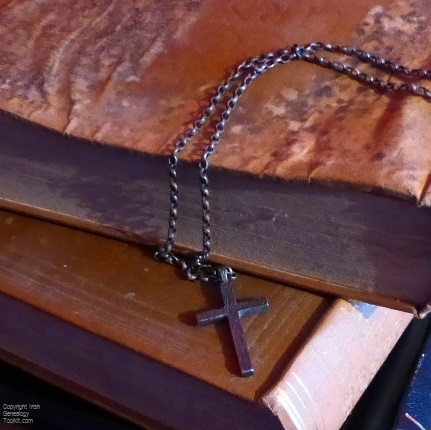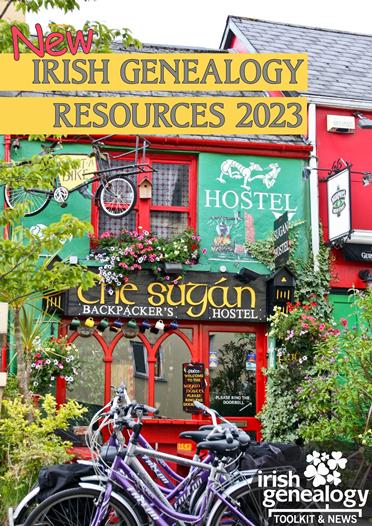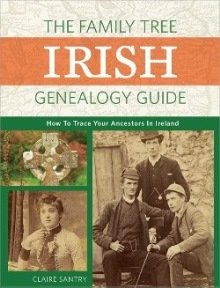- Home ›
- Church Records
Irish church records
Part 1: Overview
You'll need to get to grips with Irish church records if your family history research dates pre-1864. For births, marriages and deaths after that date, your search is best directed towards the Irish civil registration system.
To trace your ancestors in Irish church records, you'll need two crucial pieces of information: your ancestors' religion and the name of the place (town or village) where your family lived. This is because parish registers were collected locally and remain, to some extent, accessible at a localised level.
Where are the major national collections?
 Church registers
Church registersWhile there has been a concerted effort in recent
years to gather these local collections into indexed, online sources via the two main Ireland-based databases, RootsIreland.com and IrishGenealogy.ie, not all churches and heritage centres have been willing or able to pass
on their resources.
With only one notable exception - the National Library of Ireland's large collection of Irish Roman Catholic records dating up to 1882 (see below) - the three global database providers, Ancestry, FindMyPast and MyHeritage, still have relatively few Irish church records in their collections.
Back to that exception.... The National Library's unindexed database of images of RC parish registers is available free at nli.registers.ie. An index to these images was created in a partnership between Ancestry and FindMyPast in 2016; the former company includes it within its paid-for collection, while the latter chose to make it freely available. MyHeritage does not currently have an index to these images.
Do the records exist?
A second problem may occur – and it's galling where it does – if the registers no longer exist for the parishes where your ancestors lived.
For example, in the parish of Emlafad and Kilmorgan
in Co. Sligo, the Church of Ireland registers for each of baptism, marriage and
burial go back to 1762.
Excellent news for anyone who's trying to trace their family of Protestants hailing from near Ballymote.
But the news isn't so good if your ancestors from that area were Roman Catholics. Catholic baptism and marriage records for this district survive, with gaps, from 1824; indexed baptism records from 1824-1856 can only be accessed, for a fee, locally; and there are no burial records.
It could be worse! In the neighbouring parish of Achonry there are no surviving registers for either religion prior to the introduction of civil registration.
This means that 1864 is your cut-off for birth and death records if you are hoping to trace your family history in and around Tubbercurry.
The same applies for Catholic marriages (but there are civil records for non-Catholic marriages throughout Ireland back to 1845).
 St Kevin's Church, Glendalough, Co Wicklow
St Kevin's Church, Glendalough, Co WicklowObviously, this seriously limits the depth of your ancestral
research.
There is really nothing much you can do about this except accept it. And perhaps hope that by some miracle a copy of the local parish registers might, one day, be discovered intact and legible.
WHERE TO START
Where did your ancestors' live?
To trace your family in Irish church records you have to know where your ancestors lived.
This means knowing the parish.
The county, alone, will not help you much.
If you haven't yet discovered the locality, you'll need to work on finding an exact place of origin, preferably a townland, but a civil parish will do.
It's also worth making sure you understand the system of Irish parishes and other land divisions and how this may impact on your search. (See Quick Links below.)
What was your ancestor's religion?
Do you know the religion of your ancestors?
Most researchers will be able to make an educated guess about this based on the faith of more recent relatives, but be prepared for the unexpected.
In my own Irish ancestry search I was awash with Roman Catholics on every branch and twig of my family tree, but I found one lone Methodist: my gt gt grandfather, George Nichols, born in Dublin in 1844. I was really surprised.
He had married a Roman Catholic and his six children were brought up as Catholics, but he declared himself a Methodist on both the 1901 and the 1911 census.
No wonder I hadn't found his Catholic baptism record where it 'should' have been!
Where to search the records?
See Part 2: Where to find Irish church records.
Quick links/Related pages
► Part 2, Where to find Irish church records
► Find the parish/townland of origin
► Tracing Church of Ireland ancestors, Part 1
► Tracing Church of Ireland ancestors, Part 2
► Searching Roman Catholic parish registers
► Latin in the RC parish registers
Quick links/Related pages
► Part 2, Where to find Irish church records
► Find the parish/townland of origin
► Tracing Irish Protestant ancestors, Part 1
► Tracing Irish Protestant ancestors, Part 2
► Searching Roman Catholic parish registers
► Ancestral records for Irish Presbyterians
► Jewish ancestors: see Irish Jewish Genealogical Society at IrishJewishRoots


